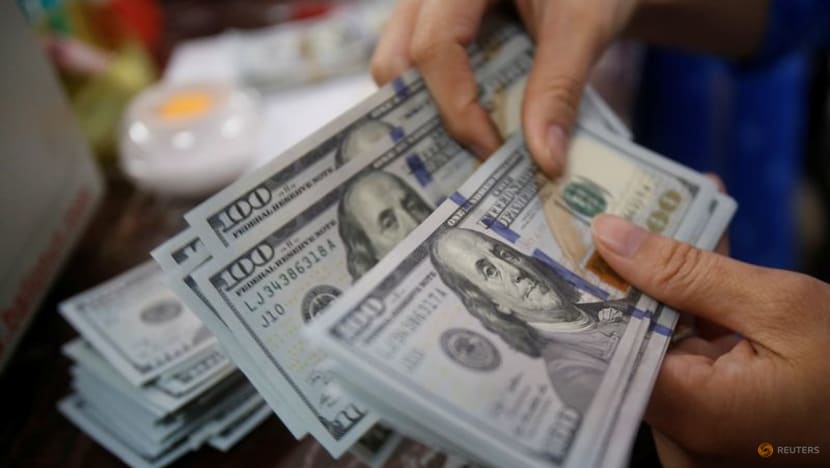Foreign currency fixed deposits see more takers amid rising interest rates, strong Singdollar
Banks in Singapore are now offering higher interest rates for some foreign currency fixed deposits than Singdollar deposits.

SINGAPORE: Rising interest rates have been attracting depositors to park their money in fixed deposits – not just in Singapore dollars but also foreign currencies.
Take-up rates for foreign currency fixed deposits surged last year, with the US dollar, Australian dollar and the British pound among the popular choices, several banks told CNA.
Some of these currencies now offer higher fixed deposit rates than Singdollar deposits, which inched up above 4 per cent this month.
For example, OCBC’s 360 account customers get a promotional rate of 5.08 per cent a year for a US dollar fixed deposit with an eight-month tenor, subject to a minimum of US$20,000. Non-360 customers get a rate of 4.88 per cent.
For a six-month deposit, OCBC offers 4.35 per cent for the first US$49,999.
DBS, the largest bank here, offers 4.41 per cent per annum for a six-month US dollar fixed deposit below S$10,000. UOB customers get 4.34 per cent a year for a placement below US$50,000 over six months.
A promotion by Standard Chartered this month offers 4.58 per cent for a minimum placement of US$25,000 over three months, and 4.98 per cent for six months. Priority banking and priority private banking customers get higher rates of 4.68 per cent and 5.08 per cent respectively.
Combined with favourable exchange rates due to a strong Singdollar, interest for such fixed deposits has grown, especially among those with foreign currency needs like overseas investments, remittances or education expenses, banks said.
DBS said the number of its foreign currency fixed deposit placements went up by 10 times in the second half of 2022 from the previous six months.
Customers preferred currencies such as the greenback, Aussie dollar, pound and Hong Kong dollar, as well shorter tenors which provide more flexibility, said Mr Brandon Lam, head of deposits and financing solutions at DBS’ consumer banking group in Singapore.
UOB said its foreign currency fixed deposit portfolio grew by more than 150 per cent last year. Popular choices include the US dollar and Australian dollar, which are “highly traded currencies for investment and savings, and also used in financing expenses such as education”.
OCBC noted that its US dollar fixed deposits grew four times versus a year ago on the back of rising interest rates. The greenback currently makes up three-quarters of the bank’s foreign currency fixed deposit placements.
The US dollar is also the top choice among customers of Standard Chartered Bank, with bookings for such fixed deposits up three times in the second half of 2022 compared to the first half of the year.
Banks said they expect demand for foreign currency fixed deposits to continue this year, especially in the first half given the challenging investment climate and as interest rates stay high.
PROS AND CONS
Foreign currency fixed deposits can generally serve as a diversification in one’s portfolio, while yielding attractive returns that are supported by the current interest rate environment, bank representatives said.
There may also be further gains if the foreign currency appreciates against the Singdollar at the time of maturity and the funds are converted back into the local currency, said Mr Tan Chin Yu, senior client adviser at wealth advisory firm Providend.
But the converse – where the foreign currency weakens against the Singdollar – may translate into potential losses. This unpredictability in exchange rates means that foreign currency fixed deposits have higher risks than Singdollar deposits.
“With the fluctuations in foreign exchange rates, it is important for the customer to be mindful of foreign exchange rates at the point of maturity of the foreign currency fixed deposits,” said DBS' Mr Lam.
“The customer will need to consider how long they are comfortable holding onto the foreign currency and their time horizon. This will enable them to ascertain an optimal time to withdraw their deposits when foreign exchange rates are in their favour.”
Mr Tan said fixed deposits are generally a useful way to earn some returns from cash set aside for short-term needs that cannot withstand volatility. With that, foreign currencies “might not be suitable due to the higher risks involved”, he added.
Another thing to note is that unlike a Singdollar fixed deposit where up to S$75,000 per depositor per bank is insured by the Deposit Insurance Scheme, foreign currency fixed deposits are not.
“Investors may risk losing all their principal and interest if the bank holding the fixed deposits defaults,” said Mr Tan.

















